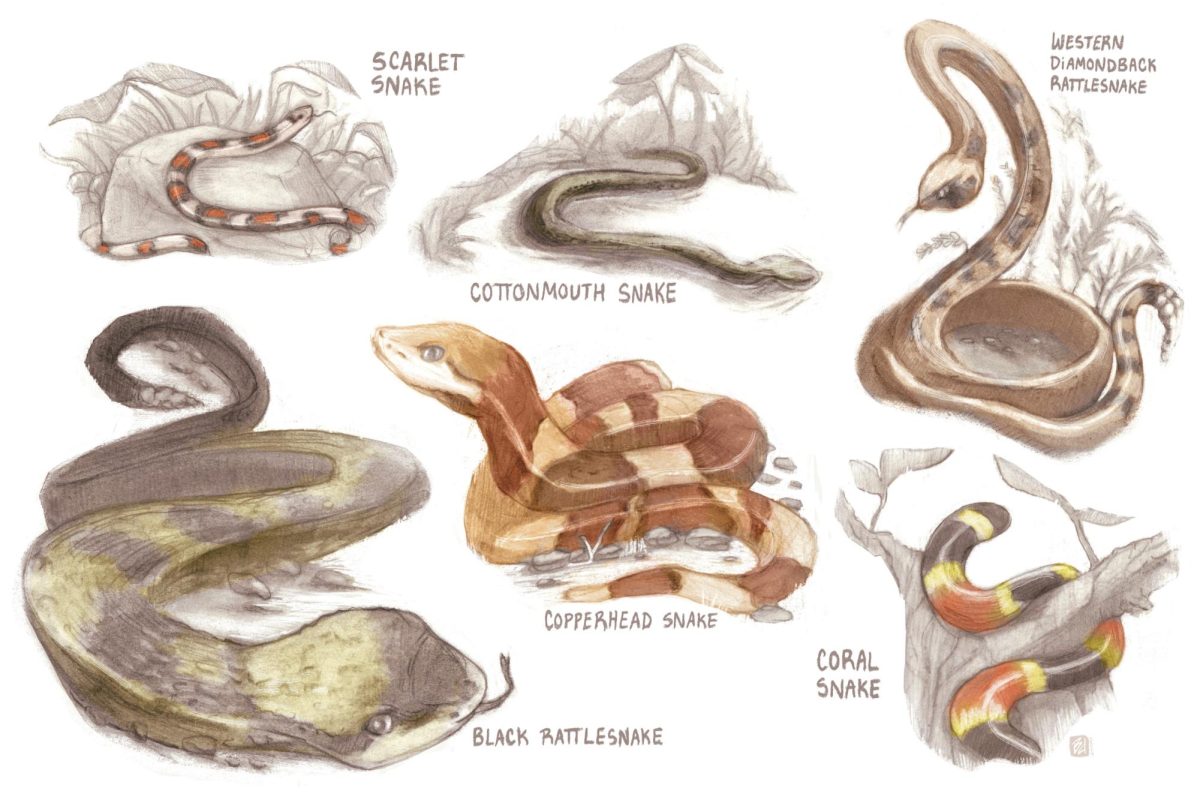Texas is home to over 105 different kinds of snake species. Encountering a snake can be a prevalent situation for a Texas native. It is essential to be prepared if ever encountered.
Many people tend to be afraid of snakes, but knowing basic information about these reptiles can help one realize that they are not as dangerous as they seem. Corey Roelke, an associate professor of Instruction in Biology specializes at UTA, said there are thing people should take into consideration when dealing with snakes.
Snakes want to be left alone and isolated. Most snakes often hide and only come out at night to avoid being seen and possibly tampered with. A snake will only make its presence known or potentially strike when it feels it has been threatened in any way.
Roelke said, “It is actually pretty hard to get bitten by snakes… most of the snake bites that occur are due to snakes being messed with.”
If one were to get bitten by a snake, it is normal to feel some pain and pressure, but it is important that emergency services are called right away. Taking a picture of the snake could help with identifying the severity of the bite. It is important to leave the snake alone after the accident. According to Texas Highways, remove any accessories you are wearing such as jewelry, watches and tight clothing, do not use any heat or ice, and do not use a tourniquet for the bite.
“It is extremely rare for a snake bite to be fatal,” Roelke said. “The healthcare system has developed a good medication that helps counter the bites. In fact, most cats and dogs that get bitten by snakes very rarely die.”
Throughout any encounter with a snake, it is best to remain calm to properly assess the situation and prevent any sort of escalation.
Types of Snakes
In Texas, there are 15 snake species that can be dangerous to humans if not handled correctly. Knowing which snakes are possibly venomous could help de-escalate a situation faster. According to Charles Swatske, a certified naturalist, most Texas citizens fear snakes and are unable to distinguish the difference between the dangerous and the harmless snakes. Swatske said, “In their minds, the only good snake is a dead snake.”
Venomous snakes in Texas are either pit vipers or coral snakes.
Pit vipers include rattlesnakes, cottonmouths and copperheads. The most common venomous rattlesnake is the western diamondback. The diamondback is often brown with hints of white and black and includes diamond shaped marks that are across their back. Other rattlesnakes include the desert and western massasauga, timber, blacktail and prairie. All these rattlesnakes are typically a brown, green or grayish color and some have diamond or round shaped marks across their back. The most distinguishable factor would be the rattle on their tail that vibrates when they want to be heard.
Cottonmouths or water moccasins are typically located in bodies of water such as rivers, ponds or swamps. They tend to be dark brown, green or black and can have bands throughout their back. The main distinctive feature of a cottonmouth is the white tissue inside their mouth, which can be shown if they feel threatened.
Copperheads tend to be a lighter color snake between the shades of red and brown and can be found in rocky and wooden areas as well as surrounding rivers.
Coral snakes can be more distinctive to spot because of their bright colors and their specific pattern. These snakes are known for being red, yellow and black, but they can also be dark, solid colors such as brown and black.
There are other snakes in Texas who have similar characteristics to the coral snake but are non-venomous such as the milk and scarlet snake. It is important to observe the color pattern to help tell the snakes apart. If the red band is next to the black band, the snake is not venomous. However, if the red band is next to a yellow band, the snake is venomous, and distance should be kept.
It is crucial to remember that snakes are a part of wildlife and contribute to Texas’s environment.
Snakes do their part by helping maintain balance in food webs; they are both predator and prey. Snakes can feed on insects, mice and possibly other snakes. They are also food for other organisms such as hawks or eagles, helping with making sure no species is overpopulated or endangered. Not only do they help with the environment, but they can also benefit humans.
According to Texas Highways, “Toxins drawn from venomous snakes have been developed to treat medical conditions such as heart disease and arthritis.”
Acknowledging these contributions can help realize that snakes are not as dangerous as they appear to be. Roelke said: “There is no reason to not like and or be afraid of snakes; they are not dangerous animals. Humans pose more threat to snakes, as many are killed each year and displaced due to their environment being destroyed”.








